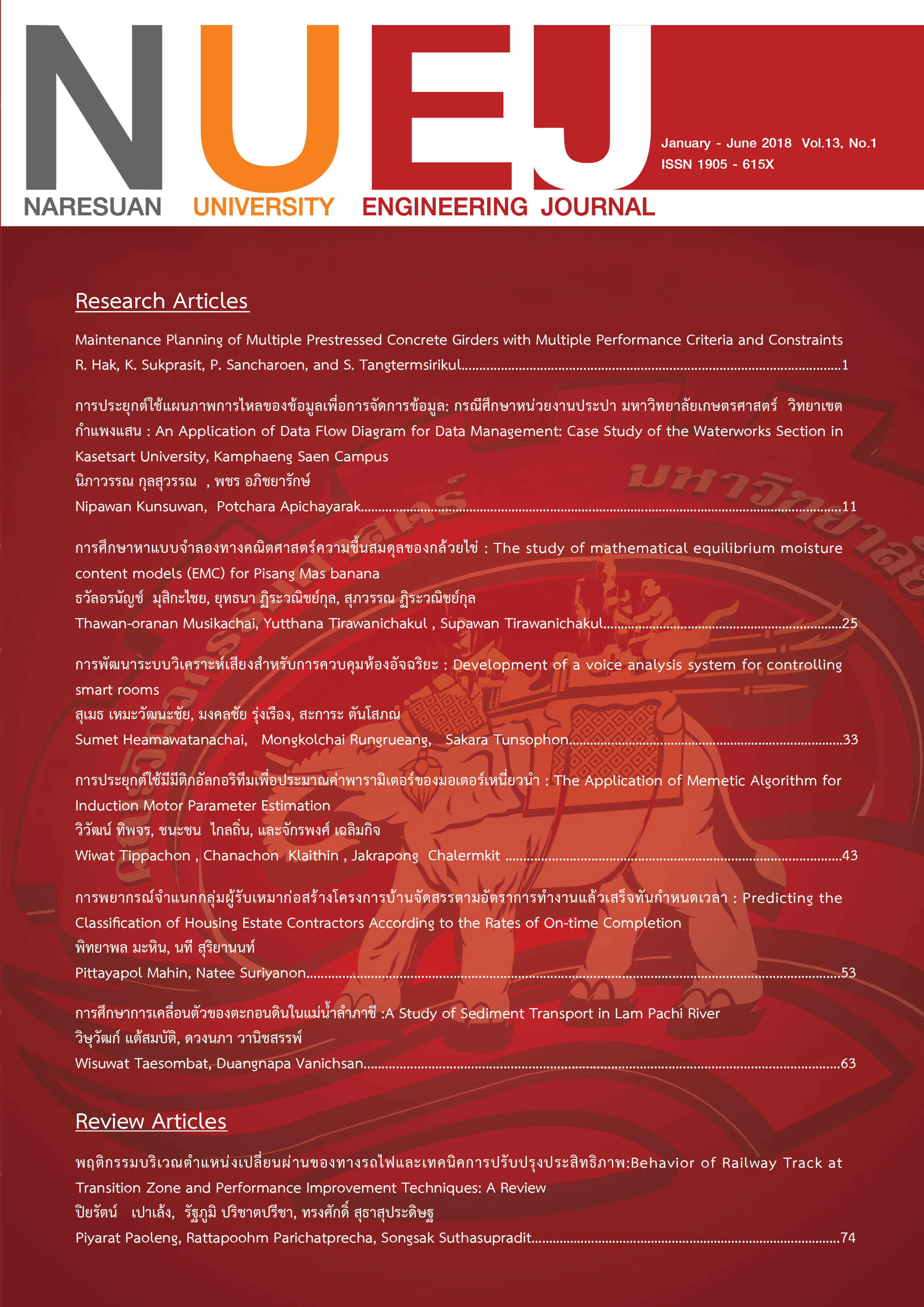การพัฒนาระบบวิเคราะห์เสียงสำหรับการควบคุมห้องอัจฉริยะ
Main Article Content
Abstract
งานวิจัยนี้เป็นการศึกษาและพัฒนาระบบวิเคราะห์เสียงเพื่อนำไปประยุกต์ใช้กับระบบควบคุมห้องอัจฉริยะ เพื่อช่วยอำนวยความสะดวกสำหรับผู้ป่วยติดเตียงในการควบคุมเครื่องใช้ไฟฟ้าต่าง ๆ โดยทั่วไปพบว่ากลุ่มผู้ป่วยติดเตียง มีปัญหาหลักคือการเคลื่อนไหวและช่วยเหลือตนเองได้ยากลำบาก จึงจำเป็นต้องรอการช่วยเหลือจากผู้ดูแล ซึ่งส่วนใหญ่ผู้ป่วยเหล่านี้ยังสามารถออกเสียงพูดได้ ดังนั้นงานวิจัยนี้จึงเป็นการพัฒนาโปรแกรมเพื่อตรวจจับและวิเคราะห์สัญญาณเสียงจากผู้ป่วยหรือผู้ใช้งาน เพื่อนำไปประยุกต์ใช้ในการควบคุมเครื่องใช้ไฟฟ้า โดยโปรแกรมนี้ถูกพัฒนาด้วยภาษา LabVIEW ทำงานโดยรับสัญญาณเสียงจากไมโครโฟนแล้วนำมาประมวลผลด้วยเทคนิค Fast Fourier Transform (FFT) เพื่อให้ได้ข้อมูลเชิงความถี่ซึ่งจะถูกแบ่งกลุ่มแล้วเปรียบเทียบกับฐานข้อมูลที่ได้ทำการบันทึกไว้แล้วด้วยวิธีการ K-Nearest Neighbor Classification (KNN) เพื่อจำแนกเสียงพูดออกเป็น 5 เสียงพื้นฐานได้แก่ เอ อี โอ อา และ อู โดยการทดสอบระบบวิเคราะห์สัญญาณเสียงโดยใช้เสียงทั้ง 5 พบว่าระบบให้ความถูกต้องเฉลี่ยมากกว่าร้อยละ 90 ในกรณีที่เลือกเสียงกลุ่มละสองเสียงที่เหมาะสมจากฐานข้อมูลมาใช้ในการสร้างรหัสควบคุม เช่น “โอ อา” “อา อู” และ “อี อา” จะสามารถให้ผลที่ถูกต้องถึงร้อยละ 99 ในกรณีที่เลือกกลุ่มละสามเสียงที่เหมาะสมเช่น “อี โอ อา” มาใช้ในการสร้างรหัสควบคุมจะให้ผลการตรวจจับที่ถูกต้องถึงร้อยละ 99 โดยสามารถปรับเลือกใช้กลุ่มเสียงให้เหมาะกับเสียงจากผู้ใช้แต่ละคนได้ โดยสรุปแล้ว ระบบที่พัฒนาขึ้นมีความถูกต้องสูงและมีศักยภาพในการนำไปช่วยผู้ป่วยติดเตียง ในการควบคุมเครื่องใช้ไฟฟ้าด้วยเสียงได้
This research presents the development of a voice activated system to assist bedridden patient in controlling of room appliance. Generally, it is hard for bedridden patients to move or to control electrical devices by themselves, thus they have to wait for caregiver to assist. Therefore, the idea of having an assistive device which can recognize patient’s voice and to control of room appliances is very challenge. The software in this research was developed using LabVIEW. The voice signal was sent to computer via microphone, then the Fast Fourier Transform technique was applied to get frequency domain data. The k-Nearest Neighbors (KNN) classification was used to compare the frequency data with the recorded database to recognize the voice. There were five defined voices in this research (a_e, ee, o_e, aa, oo) to be used for controlling. From the experiment results, using 5 voices, the developed voice recognition software achieved accuracy greater than 90%. In case of using 2 appropriated voices from 5 voices to construct control code such as “o_e, aa”, “aa, oo” and “ee, aa” the system achieve 99% accuracy. In case of using 3 suitable voices to construct control code such as “ee, o_e, aa”, the system also achieve high accuracy at 99%. It is also possible to select suitable voices to match with individual user. In conclusion, the developed system has high accuracy and has high potential to assist bedridden patients to control of room appliances using their voices.
Article Details
References
The Foundation of Thai Gerontology Research and Development Institute (TGRI), “Situation of the Thai Elderly 2014,” The Foundation of Thai Gerontology Research and Development Institute (TGRI), Institute for Population and Social Research Mahidol University, Jan. 2016.
Kumar, V., Singh, A., Tewari, M. K., & Kaur, S. Comprehension and compliance with the discharge advice and quality of life at home among the postoperative neurosurgery patients discharged from PGIMER, Chandigarh, India. Asian Journal of Neurosurgery 2016, 11(4), 372–377. http://doi.org/10.4103/1793-5482.144190
Takemasa, S., Nakagoshi, R., Murakami, M., Uesugi, M., Inoue, Y., Gotou, M., … Naruse, S. Factors Affecting Quality of Life of the Homebound Elderly Hemiparetic Stroke Patients. Journal of Physical Therapy Science 2014, 26(2), 301–303. http://doi.org/10.1589/jpts.26.301
Ruíz-Serrano, R. Posada-Gómez, A. Martínez Sibaja, G. Aguila Rodríguez, B.E. Gonzalez-Sanchez and O.O. Sandoval-Gonzalez, “Development of a dual control system applied to a smart wheelchair, using magnetic and speech control,” in The 2013 Iberoamerican Conference on Electronics Engineering and Computer Science., pp. 158 – 165
Akira Sasou and Hiroaki Kojima, “Noise Robust Speech Recognition Applied to Voice–Driven Wheelchair,” Hindawi Publishing Corp., vol. 2009, Jan. 2009.
Tiago H. Falk, Alex Andrews, Fanny Hotzé, Eric Wan and Tom Chau, “Evaluation of an ambient noise insensitive hum–based powered wheelchair controller,” Disability and Rehabilitation: Assistive Technology, 7(3), pp. 242–248, 2012.
B. Šalna and J. Kamarauskas, “Evaluation of Effectiveness of Different Methods in Speaker Recognition,” Electronics and Electrical Engineering, 2(98), 2010.
V. Anantha Natarajan and S. Jothilakshmi, “Segmentation of Continuous Speech into Consonant and Vowel Units using Formant Frequencies,” International Journal of Computer Applications, vol. 56, Oct. 2012.
Hisao Kuwabara and Kengo Ohgushi, “Role of Formant Frequencies and Bandwidths in Speaker Perception,” Elecronics and Communication in Japan, vol. 70, 1987.
Sokratis Kartakis, Vangelis Sakkalis, Panagiotis Tourlakis, Georgios Zacharioudakis and Constantine Stephanidis, “Enhancing Health Care Delivery through Ambient Intelligence Applications,” Sensors 2012, Aug. 2012.
Joe Wolfe, Mava Garnier and John Smith, “Voice Acoustics: an introduction,” UNSW. [Online]. Available: http://newt.phys.unsw.edu.au/jw/voice.html
Yussouf Nahayo and Seçkin Ari, “Performance of svm, k-nn and nbc classifiers for text–independent speaker identification with and without modelling through merging models,” SAÜ Fen Bil Der 20. Cilt, 2016


